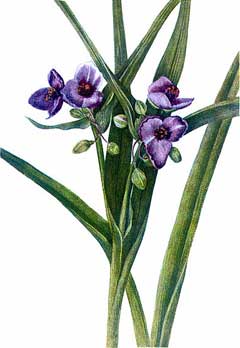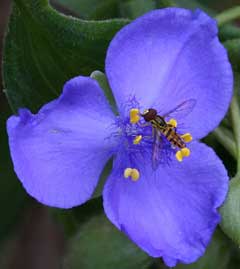 |
|
commons.wikimedia.org/wiki/File:Tradescantia_virginiana,_by_Mary_Vaux_Walcott.jpg |
 |
| commons.wikimedia.org/wiki/User:Djlayton4 |
Translate this page:
Summary
Bloom Color: Blue, Pink, Purple, White. Main Bloom Time: Early summer, Late summer, Late spring, Mid summer. Form: Spreading or horizontal, Upright or erect.
Physical Characteristics

 Tradescantia virginiana is a PERENNIAL growing to 0.4 m (1ft 4in) at a medium rate.
Tradescantia virginiana is a PERENNIAL growing to 0.4 m (1ft 4in) at a medium rate.
See above for USDA hardiness. It is hardy to UK zone 7. It is in flower from June to October, and the seeds ripen from August to October. The species is hermaphrodite (has both male and female organs). The plant is not self-fertile.
Suitable for: light (sandy), medium (loamy) and heavy (clay) soils. Suitable pH: mildly acid, neutral and basic (mildly alkaline) soils. It can grow in semi-shade (light woodland) or no shade. It prefers dry or moist soil.
UK Hardiness Map
US Hardiness Map
Synonyms
T. virginica.
Plant Habitats
Woodland Garden Sunny Edge; Dappled Shade;
Edible Uses
Edible Parts: Flowers Leaves Shoots
Edible Uses:
Leaves - raw or cooked[61, 103, 105, 213, 257]. The very young shoots and leaves can be chopped and added to salads or cooked as a potherb[183]. Flowers - raw. They make an attractive edible garnish[183].
References More on Edible Uses
Medicinal Uses
Plants For A Future can not take any responsibility for any adverse effects from the use of plants. Always seek advice from a professional before using a plant medicinally.
Kidney Laxative Poultice Women's complaints
The roots are laxative[222]. They are also used as a tea in the treatment of kidney and stomach ailments and women's complaints[222, 257]. A poultice of the leaves is applied to stings, insect bites and cancers[222, 257].
References More on Medicinal Uses
The Bookshop: Edible Plant Books
Our Latest books on Perennial Plants For Food Forests and Permaculture Gardens in paperback or digital formats.

Edible Tropical Plants
Food Forest Plants for Hotter Conditions: 250+ Plants For Tropical Food Forests & Permaculture Gardens.
More

Edible Temperate Plants
Plants for Your Food Forest: 500 Plants for Temperate Food Forests & Permaculture Gardens.
More

More Books
PFAF have eight books available in paperback and digital formats. Browse the shop for more information.
Shop Now
Other Uses
References More on Other Uses
Cultivation details
Landscape Uses:Border, Container, Ground cover, Woodland garden. An easily grown plant[233], it thrives in any good rather moist soil[1, 111]. Succeeds in dry soils[188]. Succeeds in dappled woodland shade[88, 111] or in full sun[111]. Hybridizes freely with other members of this genus[1]. Plants often self-sow in British gardens[1]. A very variable species, there are a number of named forms selected for their ornamental value[1]. Plants in this genus seem to be immune to the predations of rabbits[233]. Plants are self-sterile, at least two genetically distinct plants (and not divisions from the same plant) must be grown if seed is required. Special Features:
Attractive foliage, North American native, Naturalizing, Wetlands plant, Suitable for cut flowers, Extended bloom season in Zones 9A and above, Attractive flowers or blooms. For polyculture design as well as the above-ground architecture (form - tree, shrub etc. and size shown above) information on the habit and root pattern is also useful and given here if available. The plant growth habit is a runner spreading indefinitely by rhizomes or stolons [1-2].
References Carbon Farming Information and Carbon Sequestration Information
Temperature Converter
Type a value in the Celsius field to convert the value to Fahrenheit:
Fahrenheit:
The PFAF Bookshop
Plants For A Future have a number of books available in paperback and digital form. Book titles include Edible Plants, Edible Perennials, Edible Trees,Edible Shrubs, Woodland Gardening, and Temperate Food Forest Plants. Our new book is Food Forest Plants For Hotter Conditions (Tropical and Sub-Tropical).
Shop Now
Plant Propagation
Seed - sow spring in a cold frame. When they are large enough to handle, prick the seedlings out into individual pots and grow them on in the greenhouse for their first winter. Plant them out into their permanent positions in late spring or early summer, after the last expected frosts. Division in spring or autumn[111]. Cuttings of young shoots, July in a frame. They root easily and quickly.
Other Names
If available other names are mentioned here
Native Range
NORTHERN AMERICA: Canada, Ontario (south), United States, Connecticut, Indiana, Maine, Massachusetts, Michigan, New Hampshire, New Jersey, New York, Ohio, Pennsylvania, Rhode Island, Vermont, West Virginia, Illinois, Iowa, Missouri, Oklahoma, Wisconsin, Alabama, Arkansas (n.w.?), Delaware, Georgia, Kentucky, Maryland, Mississippi (n.?), North Carolina, South Carolina, Tennessee, Virginia, District of Columbia,
Weed Potential
Right plant wrong place. We are currently updating this section.
Please note that a plant may be invasive in one area but may not in your area so it's worth checking.
Conservation Status
IUCN Red List of Threatened Plants Status :

Growth: S = slow M = medium F = fast. Soil: L = light (sandy) M = medium H = heavy (clay). pH: A = acid N = neutral B = basic (alkaline). Shade: F = full shade S = semi-shade N = no shade. Moisture: D = dry M = Moist We = wet Wa = water.
Now available:
Food Forest Plants for Mediterranean Conditions
350+ Perennial Plants For Mediterranean and Drier Food Forests and Permaculture Gardens.
[Paperback and eBook]
This is the third in Plants For A Future's series of plant guides for food forests tailored to
specific climate zones. Following volumes on temperate and tropical ecosystems, this book focuses
on species suited to Mediterranean conditions—regions with hot, dry summers and cool, wet winters,
often facing the added challenge of climate change.
Read More
Expert comment
Author
L.
Botanical References
43200
Links / References
For a list of references used on this page please go here
Readers comment